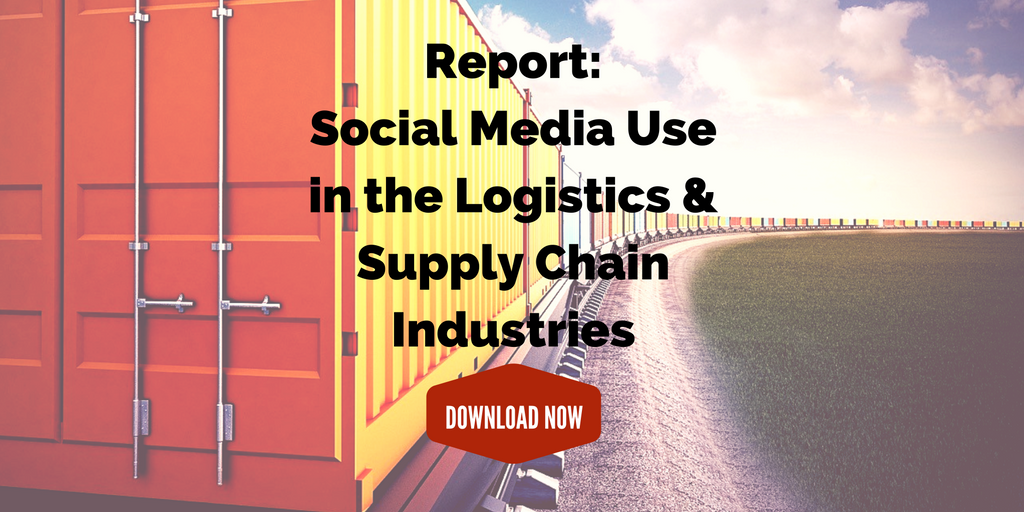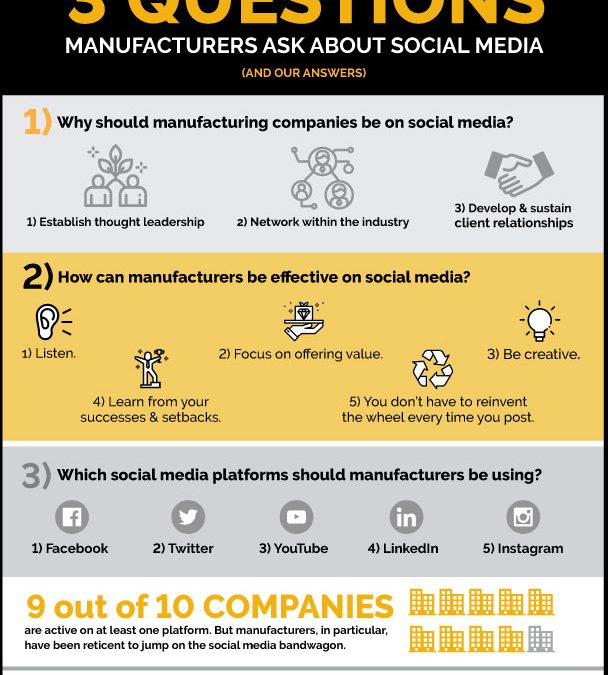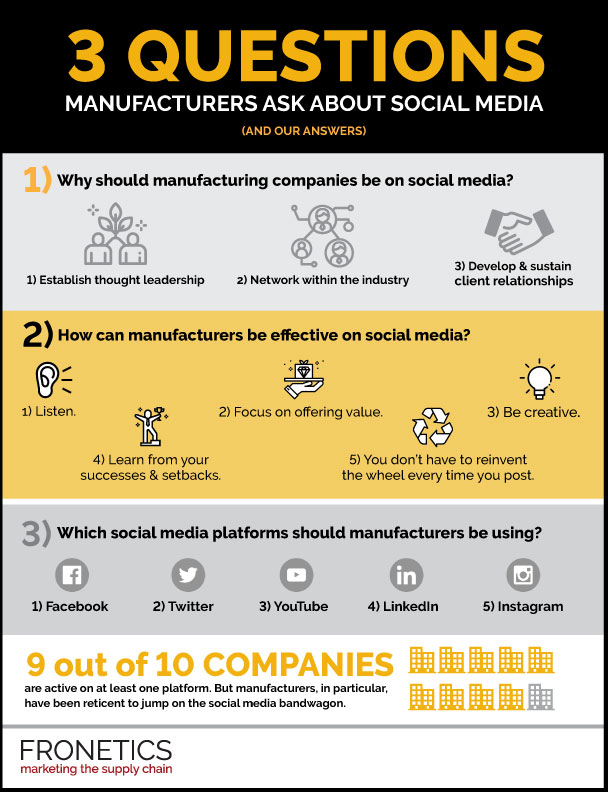
by Fronetics | May 8, 2019 | Blog, Content Marketing, Logistics, Manufacturing & Distribution, Marketing, Strategy, Supply Chain
Brand awareness is key in optimizing your content marketing efforts but can be challenging to quantify. Here are four metrics to help you measure brand awareness.
Highlights:
- Use tools, like SharedCount, to track the number of times a piece of your content has been shared across different social media platforms.
- Use the analytics from blog share bars to track the popularity of your posts and help shape content for your editorial calendar.
- Taking the time to measure brand awareness will ultimately help you in optimizing your digital marketing efforts.
Video transcript:
I’m Katie Russell and I’m a marketing strategist here at Fronetics. Today I’m going to talk to you about four ways to measure brand awareness for your packaging company.
Brand awareness is the extent to which customers – both potential and current – are able to recognize your brand. It is key in optimizing your digital marketing efforts, but it can be hard to quantify. Here are four metrics to help you start measuring brand awareness for your packaging company.
1. Social media reach
Social media reach is the total number of people that your content can reach across social media platforms. Use tools like SharedCount to track the number of times a piece of your content has been shared across different social media platforms, like Facebook, Instagram, and even LinkedIn. This can help you figure out what platforms perform best for your content and can also help you shape the kind of content that you’re putting on social media platforms.
2. Brand mentions
How people talk about your packaging company online? If they are, you need to know about it. Try tracking tools like Google Alerts or Hootsuite to make sure that you know every single time someone talks about your packaging brand or any of your products or services.
3. Blog shares
Here are Fronetics, we talk a lot about the importance of having a blog that posts valuable and informative content to your readers. What’s also important is giving your readers the ability to share this content. It’s as easy as adding a share tool to the side of your blog posts. This helps you reach a larger audience and gain views from people that normally wouldn’t see your content. You can also use the analytics from these share bars to track the popularity of your posts and help shape content for your editorial calendar.
4. Search volume
Use tools like Google Adwords or Moz to track searches for your brand, products, even your blog and social media posts. It can help in refining your keywords that you use throughout your content to know specifically what people are searching for when they’re searching for your packaging brand.
Taking the time to measure brand awareness will ultimately help you in optimizing your digital marketing efforts and will also help increase leads. IF you need more information or need help getting started measuring your brand awareness, visit us at fronetics.com.
Related posts:


by Fronetics | May 7, 2019 | Blog, Content Marketing, Logistics, Marketing, Social Media, Supply Chain
When it comes to social media, timing is everything. These 5 tools will help you determine the best time to post on social media for your business.
Highlights:
- Social media is playing an increasing role in B2B purchasing decisions.
- Even if you’re posting great content, if you’re doing it at the wrong times, you’re losing out.
- Social media management tools can help you understand your audience and make informed decisions about post timing.
If you’re a B2B marketer, chances are, you’re well aware of the importance of social media. But since, as BuzzFeed’s Jonathan Perelman famously put it, “Content is king, but distribution is queen, and she wears the pants,” simply posting your content is only half the battle. Knowing the best time to post on social media is nearly as important as what you post.
It’s difficult to overstate importance of an effective social media strategy. Not only do 78% of marketers who have used social media for 2 years or more report increased traffic to their websites, but B2B decision-makers increasingly report that they are influenced by social media when purchasing. According to Demand Gen’s 2018 B2B Buyers Survey Report, more than half (54%) of all B2B buyers rely on social media to research vendor solutions.
[bctt tweet=”Not only do 78% of marketers who have used social media for 2 years or more report increased traffic to their websites, but B2B decision-makers increasingly report that they are influenced by social media when purchasing.” username=”Fronetics”]
These are powerful numbers, and all signs point to social media playing an ever-increasing role in the B2B buyer’s journey. For your social media content to pack the biggest punch, you need to be posting at the optimal times. Luckily, there are a plethora of social media management tools that can help you refine your strategy. Here are our 5 favorite tools for determining the best time to post on social media for B2B brands.
5 tools for determining the best time to post on social media
1) Google Analytics
This robust analytical tool is among the most popular all-around web tools for B2B businesses, and for good reason. Google Analytics can help you determine how your audience is interacting with all your digital assets, and it offers some great insights about social media in particular. You can create various types of custom reports based on your business’ goals and results. We recommend three in particular to help you find the best time to post on social media:
- Best Days to Post on Social Media
- Best Time to Post on Social Network by Hour
- Social Media Traffic by Date and Hour
2) Buffer
A company with an impressive record when it comes to social media management, Buffer’s platform lets you easily manage all your social media platforms. Like its biggest rival, Hootsuite (more on that soon), Buffer offers among its features some useful insights for determining ideal post timing and frequency. For example, it analyzes follower activity and suggests the perfect moments to post on each social media platform.
3) Hootsuite
Hootsuite has been one of our favorite tools for a long time, and it truly offers a rich variety of features and insights to maximize the effectiveness of your digital assets. Not only is it effective at scheduling social media posts, it’s an excellent tool for measuring social media ROI — no easy task! Hootsuite’s AutoSchedule feature is one of its best assets. For each piece of content you plan to post on social media, it analyzes when similar content performed best in the past and determines the optimal post time. In addition, it considers the platform and publishes based on audience engagement on each network.
4) Followerwonk
Followerwonk is new to our list, and it’s different from most social media management tools. While it doesn’t offer the kind of scheduling and management features as the other platforms on our list, what it does do extremely well is help you gain valuable insights and understanding of your audience. For example, Followerwonk lets you analyze your current Twitter followers by things like location, post timing, engagement, accounts they follow, and more, as well as contrast those relationships with your competitors. Understanding your followers at this level will not only help you determine when your business should post on social media, but will allow you to analyze and adjust your strategy in all kinds of ways.
5) SproutSocial
Another perennial favorite, SproutSocial offers the whole menu of social media management tools: everything from monitoring to scheduling to analytics. The customized dashboard gives you a bird’s eye overview of how your social media channels are performing. You can find deeper insights, including individual statistics on each post, and customer data like gender, age, and location demographics. The platform’s ViralPost technology boasts impressive results at finding the best time to share your content.
Figuring out the best time to post on social media for your business is no easy task, but it’s key to getting your content to reach your target audience. There’s no one-size-fits-all solution, and any one, or a combination, of these tools can help you understand your audience better and get your content out to them at the right times.
Related posts:


by Fronetics | May 2, 2019 | Blog, Content Marketing, Logistics, Manufacturing & Distribution, Marketing, Strategy, Supply Chain
As automation technologies become increasingly sophisticated, companies throughout the supply chain are realizing the beneficial impact of automation on materials handling.
Highlights:
- Manufacturers of automation technologies are predicted to grow significantly over the next 5 years.
- Automating the “first mile” of the supply chain helps reduce labor challenges and leads to increased productivity.
- Robotics technologies offer greater capacity for data collection, facilitating informed process decisions.
While the impact of automation on the “last mile” of the supply chain is often the subject of public interest, automation in the “first mile” deserves just as much attention. Advanced robotics are increasingly ensuring accuracy — while minimizing or even eliminating human involvement in various processes — at every stage of the supply chain. Industry experts are predicting an ever-growing impact of automation on materials handling, with companies reaping the benefits up and down the supply chain.
Particularly in the materials-handling sector, human capital is increasingly difficult to recruit and maintain. Additionally, labor costs in global markets such as India and China are rising. Naturally, companies are increasingly inclined to replace or redeploy human labor, with the help of automated material-handling systems.
Not to mention, the increasing sophistication of machine-learning capabilities or AI within available automation technologies allows for even greater productivity. And there’s strong reason to believe that we’re only seeing the beginning of what automation can do. Vendors who create these technologies are investing heavily in R&D, aggressively attempting to expand their product offerings to meet specific industry demands while complying with the complex standards and regulations in place.
Quantifying the costs and impact of automation on materials handling
The robust growth in the robotics-equipment-manufacturing sector demonstrates that the materials-handling industry is investing in automation. Thanks to the demand for high-performance robotics systems, New Equipment Digest (NED) predicts that within the materials-handling-equipment sector, the robotics segment will grow by over 8%, reaching $20 billion by the year 2024. The overall material-handling-equipment market is expected to surpass $190 billion by the same year, according to a growth forecast report by Global Market Insights, Inc.
“Growing automation capabilities in the manufacturing space coupled with increasing penetration of advanced technologies, such as IoT, RFID, and AI, are expected to drive the material-handling-equipment market growth,” predicts the NED. These technologies are already increasing productivity and throughput in the materials-handling sector and reducing the potential for human error. The predicted growth in the manufacturing of robotics equipment points to the increasingly positive impact of automation supply chain-wide.
Of course, automation is not without its challenges. Companies face technical issues involved in implementation, not to mention the large capital outlay required to invest in costly equipment and technologies. With increased technical sophistication and network utilization, there are threats to cybersecurity, requiring companies to invest in measures to protect their technology.
Robotics-equipment manufacturers recognize that while automation offers significant benefits for materials handling, companies need to study potential impact before making these costly investments.
Many manufacturers are offering tools for quantifying the impact of automation on materials handling. OTTO Motors, a manufacturer of self-driving-vehicles, offers an ROI calculator, allowing potential buyers the opportunity to receive an easy ROI estimate. Manufacturers are also increasingly offering simulations of materials-handling systems, allowing potential customers to determine efficacy, test designs, and study new procedures without disrupting operations.
Realizing the benefits of automation for materials handling
Beyond the well-known benefits, such as decreased costs and increased productivity, automating materials-handling processes can offer a variety of additional advantages to companies’ first-mile operations. In fact, streamlining these processes and reducing costs has its own positive repercussions throughout a company’s operations, as it allows for increased speed, productivity, and accuracy operation-wide.
[bctt tweet=”Automating materials-handling processes has its own positive repercussions throughout a company’s operations, as it allows for increased speed, productivity, and accuracy operation-wide.” username=”Fronetics”]
Additional benefits of automating materials handling include:
- The access to real-time data provided by automated technologies allows for more complete Key Performance Indicators (KPIs).
- Labor shortages and high turnover are some of the primary challenges in materials handling – automation shields manufacturers from these challenges, while allowing human labor to be repurposed into more intricate tasks.
- Implementing technology in the materials-handling phase of the supply chain can connect to other automated processes within the factory.
- The availability of data and the ability to leverage it allows adjustments to be made in real time, meaning more flexible manufacturing.
The bottom line is that, while it can be costly at the outset, automation at the front end of the supply chain, namely materials handling, offers rich and diverse benefits sector-wide.
Related posts:


by Fronetics | May 1, 2019 | Blog, Content Marketing, Logistics, Manufacturing & Distribution, Marketing, Social Media, Supply Chain
We get many queries from manufacturers about social marketing — mostly, why and how should I use it — so here are our answers to the most-popular questions manufacturers ask about social media.
Highlights:
- Facilitate networking opportunities, thought leadership, and prospect/client relationships.
- Consider using popular platforms like YouTube and Instagram to engage users and drive website traffic.
- Don’t use social media to push your products.

(Made with Canva)
B2B operations have increasingly embraced social media as a strategic marketing tool. In fact, 9 out of 10 companies are active on at least one platform. But manufacturers, in particular, have been reticent to jump on the social media bandwagon.
If your manufacturing operation isn’t making use of social media as a tool to engage with your audience, you’re missing out on big lead generation potential. Manufacturers like the Dow Chemical Company, ArcelorMittal, and CAT Products are among those that have figured out how to harness the power of social media.
To help you launch or refine your efforts, we’ve put together the following answers to the most-popular questions manufacturers ask about social media.
Why should manufacturing companies be on social media?
There are three major reasons that manufacturing brands should be all over social media:
- Establish thought leadership
- Network within the industry
- Develop and sustain client relationships
Notice that none of these involve selling products. As with content marketing in general, good social media marketing isn’t about pushing your products.
[bctt tweet=”The value of social media for manufacturers is in its potential to establish and expand thought leadership and to cultivate meaningful and fruitful relationships within your industry and among prospects and clients.” username=”Fronetics”]
To make the most of social media as a marketing tool, abandon the idea that it’s about blatant sales pitches. Instead, approach it from the perspective that it’s an inherently social tool – that is, its value for manufacturers is in its potential to establish and expand thought leadership and to cultivate meaningful and fruitful relationships within your industry and among prospects and clients.
Which social media platforms should manufacturers be using?
Not all social media platforms are created equal. Each requires its own strategy, content format, and media. We recommend that manufacturers consider these five platforms:
1) Facebook
Facebook is an excellent place to share content with a wide segment of your audience, to promote engagement (through likes, comments, and shares), and to engage with peers and prospects. Not only that, the savviest marketers are using Facebook to understand their industry better – everything from strategies of peer brands to a fuller picture of your target buyer persona to the informational or product needs of your prospects.
2) Twitter
Twitter’s format is about brief, pithy content, used to engage with and inform your audience. This is an ideal place to let customers know what you’re planning next, to establish your corporate personality, and to let your audience in on a slice of your day-to-day operations and values.
3) YouTube
Video marketing for manufacturers is skyrocketing. With video being the most popular form of content online today, YouTube is an obvious choice for marketers. Whether it’s “how to” videos, footage of your operations, or interviews with subject-matter experts, your brand should be using YouTube to drive search traffic and educate prospects.
4) LinkedIn
B2B marketers unequivocally rank LinkedIn as the most effective network for lead generation, follower engagement, and traffic to their websites. An ideal place to engage with industry leaders, LinkedIn is also great for distributing content to a focused audience.
5) Instagram
The popularity of this highly visual platform has continued to skyrocket – it’s currently the second-most-used social media platform (up from fourth just two years ago). And believe it or not, this picture-based network is a powerhouse for B2B brands. We’ve written extensively about how brands can leverage Instagram and Instagram Stories. Suffice it to say, this is a perfect place to post your most engaging visual content and actively engage with followers.
How can manufacturers be effective on social media?
As with any content marketing effort, a well-thought-out social media strategy is a big part of success. As you create and begin to implement your strategy, start with these five tips.
1) Listen.
Before you post even a single piece of content, start by listening to your audience. In the days before social media, marketers had it much harder when it came to determining audience needs and preferences. Use these platforms to research your target prospects, as well as how competitors are engaging followers. Make note of the questions your target audience has, frustrations or challenges they express, and what types of content they engage with.
2) Focus on offering value.
You’d be surprised how many manufacturers neglect to place a premium on simply being useful with their social media content. It’s not complicated: If you post relevant, valuable content for your target audience, you’ll boost engagement, grow brand awareness, and generate and convert more leads.
3) You don’t have to reinvent the wheel every time you post.
One of the great things about social media is that it rewards not only content creation, but content curation. While you do want to be posting original content most of the time (experts recommend about 60%), a good chunk of your posting activity should include curating relevant content from third parties to share with your followers.
4) Be creative.
Separating yourself from your competitors can be a challenge, but it’s one worth striving toward. Start by asking yourself what makes your operation unique, what’s special about your process, what industry-leading expertise does your executive team have, what unusual perspective can you offer? Next, start breaking these four rules.
5) Learn from your successes and setbacks.
There are many tools out there to help you track the results of your social media efforts. Determine the right KPIs for your business and keep track of your results relentlessly. These metrics will allow you to study your impact and frequently tailor your strategy accordingly.
It’s time for manufacturers to fully embrace the marketing potential of social media. Whether you create and implement your own strategy, or decide to outsource your social media efforts, social media is a powerful set of tools that manufacturers should be harnessing.
Are there other questions manufactures ask about social media that we missed? Let me know in the comments.
Related posts:


by Fronetics | Apr 30, 2019 | Blog, Current Events, Marketing, Social Media, Video Marketing
Also, this month in social media news: LinkedIn adds a “Teammates” option to facilitate connections among colleagues, and Facebook is testing a Stories-like newsfeed.
Highlights:
- Facebook is giving users increased access to what information advertisers have on them.
- Instagram is considering joining Facebook in promoting communal video experiences.
- LinkedIn’s “Teammates” feature helps users prioritize content from close connections.
This month in social media news, Facebook is continuing to combat user privacy concerns by introducing a tool to provide greater transparency about the content they see on their Newsfeeds, both from connections and from advertisers. The platform is also continuing to explore the Stories trend, as it conducts early-stage testing of a layout that resembles the Stories feature more than it does the existing Newsfeed.
Both Instagram and LinkedIn are promoting greater community among users. Instagram is testing a group video viewing option, joining Facebook’s Watch Party, introduced last year. LinkedIn is rolling out a feature which allows users to prioritize content from their closest connections. Read on for a round-up of social media news.
Facebook Introduces a Feature to Assist Users in Understanding the Context of Content Appearing on the Newsfeed
Having been embroiled in ongoing privacy-related scandals, Facebookis making users’ safety and comfort using the platform a priority. To that end, the company has announced that it will be giving users greater control over the content that appears on their Newsfeeds, through the “Why am I seeing this post?” feature.
[bctt tweet=”Facebook has announced that it will be giving users greater control over the content that appears on their Newsfeeds, through the “Why am I seeing this post?” feature.” username=”Fronetics”]
In 2014, the social media giant launched its similar feature, “Why am I seeing this ad?” which was geared toward projecting transparency in the company’s embattled relationship with users and their advertising content. Facebook announced simultaneously that it will be “making improvements” to the older feature. The new “Why am I seeing this post?” feature aims to help users understand the context for what shows up in their Newsfeeds, and it also allows them to control and manage content.
Marketers should be aware that users will now be able to find out when their profile information matches with the information on an advertiser’s list, as well as when an advertiser “saves their personal information in their database and other details such as if they (the users) were targeted by the advertiser through another marketing partner of theirs (advertisers).”
Instagram Tests a Communal Video Viewing Option
Social media platforms are continuing to push the boundaries of social experiences that are possible for users not in physical proximity. Back in 2018, Facebook rolled out its “Watch Party” option, and now Instagram is exploring jumping on the bandwagon, testing a similar function in its app.
The feature would allow users to view video content on Instagram with a friend, while simultaneously seeing their reactions on screen, using the phone’s camera, in a split-screen view. Users can also apply face filters and other visual tools to the personal feed. Instagram and Facebook’s features are part of a larger trend toward “multi-participatory consumption.”
LinkedIn Adds a New “Teammates” Option to Maintain Connections Among Colleagues
In an ongoing attempt to boost on-platform engagement, LinkedIn has introduced a new feature called “Teammates.” It enables users to put a priority on updates from immediate connections, content with which LinkedIn has found that its users are 60% more likely to engage than more distant connections. As users place a priority on updates from teammates, it will appear higher in their feeds.
The network is pushing the feature as promoting community within the workplace: “95% of working professionals think it’s a good idea to have friends at work, and 63% say they have relationships with their co-workers outside the office. Based on a recent study we shared last month, having friends at work can also help you advance your career.”
Marketers should take note, since it’s not immediately clear what the impact of this feature will be on branded content. Nonetheless, it emphasizes the value of cultivating meaningful connections on the platform, as potential clients will be more likely to mark these types of connections as “teammates,” placing a higher priority on their content.
Facebook is Testing a Stories-Like Swipeable Newsfeed
Stories features across the social media landscape continue to grow in popularity. In keeping with the trend, Facebook is experimenting with a Newsfeed layout which allows users to side-scroll or swipe between posts in their feed, rather than scrolling down. This is a potential significant re-design for the platform, and points to the fact that the Stories trend is here to stay.
If Facebook adopts the design, it would merge Stories and Newsfeed content into a single stream. The network emphasized to TechCrunchthat it is “in the very early stages of development,” and “still needs to conduct a lot more user research before any public experimentation can take place.”
Therefore, while it’s unlikely that a new Newsfeed is coming soon, what is clear is that social media platforms are experimenting with increasingly integrating Stories-style content into every aspect of the user experience.
Related posts:


by Jennifer Hart Yim | Apr 25, 2019 | Blog, Supply Chain, Talent
New research backs up what we already know: the supply chain economy is a hotbed of innovation, and that opens up immense professional opportunities.
Highlights:
- New research assigns some numbers to two facts that every Supply Chain professional knows: the sector is full of opportunity for professionals and it is a hotbed for innovation.
- Supply Chain industry innovations have a tendency to reverberate and cascade throughout the wider economy as they filter from suppliers, to the companies they supply, and finally to the consumer.
- People who are able to harness and drive supply chain innovation have some of the brightest job prospects in tomorrow’s economy.
This guest post comes to us from Argentus Supply Chain Recruiting, a boutique recruitment firm specializing in Supply Chain Management and Procurement.
A new Harvard Business Review article lays out some striking research out of MIT about the role of Supply Chain Management within the broader economy. Written by Mercedes Delgado and Karen Mills, the study seeks to better define what constitutes the “Supply Chain” part of the economy, and what doesn’t. The goal? To better define Supply Chain Management’s place in the broader economy, and the role it plays in terms of innovation.
The researchers define “Supply Chain” industries as any industries that sell upstream to businesses and government entities. It excludes industries selling direct to consumer (B2C). It’s a bit of a curious definition – what about the B2C companies with strong supply chain and distribution networks? – but we’ll roll with it.
In short, the research assigns some numbers to two facts that every Supply Chain professional knows: the sector is full of opportunity for professionals. It’s also a hotbed for innovation which has a tendency to filter into other sectors of the economy.
The MIT researchers studied the historical role that these Supply Chain companies have played in American innovation. For example, Intel’s semiconductors and Microsoft’s enterprise software are innovations with their roots in the supply chain – supplying to companies – that are almost unparalleled in terms of their downstream effect on the overall economy, as well as the daily experience of the average person.
The researchers make an interesting point: compared to “B2C” industries, Supply Chain industry innovations have a tendency to reverberate and cascade throughout the wider economy as they filter from suppliers, to the companies they supply, and finally to the consumer. Technologies like cloud computing –which is now sold to 90% of industries – have their roots in the Supply Chain, which helps them diffuse across industries as they spread downstream and become integral to the economy. In Delgado and Mills’ estimation, this “trickling down” gives these innovations a multiplying effect that isn’t found in more consumer-facing industries.
Put aside the fact that the most successful consumer-facing companies of the past several decades have been tremendously innovative (Apple and Amazon, for example) – in part because of their Supply Chain practices – and it’s an intriguing idea. The fact is, Supply Chain management drives innovation, and the people who drive that innovation have some of the brightest job prospects out of anyone in the economy.
People in Supply Chain are more likely to be in STEM (Science, Technology, Engineering and Math) than the wider economy. They’re also better compensated – perhaps as an indirect result of their contributions to innovation.
Here are a few of the most interesting – and exciting – top-level stats from the research:
- In the U.S. – which the study examined – 44 million jobs are in Supply Chain, or 37% of the overall economy.
- The average wage of Supply Chain-related jobs was much higher than average, at $61,700 – compared to $39,200 for non-Supply Chain jobs.
- 4% of Supply Chain jobs were STEM-related jobs – considered a predictor of innovation – compared to only 2.1% of non-Supply Chain jobs.
- 6% of new patents in the U.S. evolve from the Supply Chain sector.
The researchers chart another interesting distinction and trend, towards the importance of Supply Chain Services from traditional manufacturing. Supply Chain services jobs – including logistics, engineering, cloud computing, and others – have grown massively to encompass 80% of jobs in the sector, but most still consider Supply Chain to mean traditional manufacturing jobs such as metal stamping or injection molding operators.
Supply Chain Services workers have the highest STEM intensity out of everyone in the economy (19%), which also coincides with the highest wages ($80,800 a year, on average). This tracks with a trend in the wider economy towards services and away from traditional manufacturing, and shows what we know to be the case: despite panic about automation, Supply Chain professionals who can innovate are in very high demand.
Whether you agree or disagree with Mills and Delgado’s definitions and findings, it’s clear to anyone paying attention that the Supply Chain is a force-multiplier for innovation to the economy. It’s truer now than it’s ever been, and people who are able to harness and drive that innovation have some of the brightest job prospects in tomorrow’s economy.
Do you agree with the authors’ definition of Supply Chain? Is it too broad, not broad enough, or is it right on the money? We’re curious to hear anything else you might have to add about the importance of Supply Chain for innovation in the wider economy!
In the meantime, we encourage everyone to check out the HBR article as well as the authors’ original study, which has some fascinating insights about the role Supply Chains play in innovation.
Related posts:










